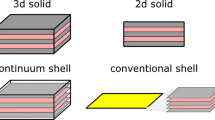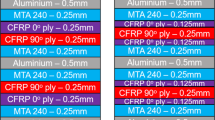Abstract
Structural impact tests were first presented to cover typical fibre metal laminates (FMLs) subjected a low velocity projectile impact, which produced the corresponding load-displacement traces and deformation/failure modes for the validation of numerical models. Finite element (FE) models were then developed to simulate the impact behaviour of FMLs tested. The aluminium (alloy grade 2024-0) layer was modelled as an isotropic elasto-plastic material up to the on-set of post failure stage, followed by shear failure and tensile failure to simulate its failure mechanisms. The glass fibre laminate (woven glass-fibre reinforced composite) layer was modelled as an orthotropic material up to its on-set of damage, followed by damage initiation and evolution using the Hashin criterion. The damage initiation was controlled by failure tensile and compressive stresses within the lamina plane which were primarily determined by tests. The damage evolution was controlled by tensile/compressive fracture energies combined with both fibre and matrix. The FE models developed for the 2/1, 3/2 and 4/3 FMLs plates made with 4-ply and 8-ply glass fibre laminate cores were validated against the corresponding experimental results. Good correlation was obtained in terms of load-displacement traces, deformation and failure modes. The validated models were ready to be used to undertake parametric studies to cover FMLs plates made with various stack sequences and composite cores.
Similar content being viewed by others
References
Vlot A. Glare—History of the Development of a New Aircraft Material. Dordrecht: Kluwer Academic Publishers, 2001
Krishnakumar S. Fiber metal laminates—The synthesis of metals and composites. Mater manuf processes, 1994, 9: 295–877
Reyes G, Cantwell W J. The mechanical properties of fibre-metal laminates based on glass fibre reinforced polypropylene. Compos Sci Technol, 2000, 60: 1085–1094
Vlot A, Gunnink J W. Fibre Metal Laminates: An Introduction. Dordrecht: Kluwer Academic Publishers, 2001
Vogelesang L B, Vlot A. Development of fibre metal laminates for advanced aerospace structures. J Mater Process Technol, 2000, 103: 1–5
Vlot A, Kroon E, Rocca G. Impact response of fiber metal laminates. Key Eng Mater, 1998, 141–143: 235–276
Cantwell W J, Wade G, Guillen J F, et al. The impact response of lightweight fiber-metal laminates. In: Proceedings of ASME Conference, paper AM16A. New York: ASME, 2001
Vlot A, Fredell R S. Impact Damage Resistance and Damage Tolerance of Fibre Metal Laminates. In: Proceedings of the 9th International Conference on Composite Materials. Madrid: Woodhead Publishing Limited, 1993. 51–58
Vlot A. Impact loading on fibre metal laminates. Int J Impact Eng, 1996, 18: 291–307
Vlot A, Krull M. Impact damage resistance of various fibre metal laminates. J Phys, 1997, IV 07 C3: 1045–1050
Vlot A, Vogelesang L B, Vries T. Towards application of fibre metal laminates in large aircraft. Aircraft Eng Aerosp Technol, 1999, 71: 558–570
Abdullah M R, Cantwell W J. The impact resistance of polypropylenebased fiber metal laminates. Compos Sci Technol, 2006, 66: 1682–1693
Caprino G, Spataro G, Del L S. Low-velocity impact behavior of fiber glass-aluminium laminates. Compos-Part A, 2004, 35: 605–616
Iannucci L. Progressive failure modelling of woven carbon composite under impact. Int J Impact Eng, 2006, 32: 1013–1043
Tsai S W, Wu E. A general theory of strength for anisotropic materials. J Compos Mater, 1971, 5: 58–80
Choi H Y, Wu H Y, Chang F K. A new approach towards understanding damage mechanism and mechanics of laminated composites due to low velocity impact: Part II-analysis. J Compos Mater, 1991, 25: 1012–1038
Kim R Y, Soni S R. Experimental and analytical studies on the onset of delamination in laminated composites. J Compos Mater, 1984, 18: 70–80
Corigliano A, Mariani S, Pandolfi A. Numerical analysis of ratedependent dynamic composite delamination. Compos Sci Technol, 2006, 66: 766–775
Vaziri R, Olson M D. Finite element analysis of fibrous composite structures: A plasticity approach. Compos Struct, 1992, 44: 103–116
Molinari A, Ravichandran G. Modeling plastic shocks in periodic laminates with gradient plasticity theories. J Mech Phys Solids, 2006, 54: 2495–2526
Lee U. A theory of continuum damage mechanics for anisotropic solids. J Appl Mech ASME Trans, 1999, 66: 264–268
Laws N, Dvorak G J, Hejazi M. Stiffness changes in unidirectional composites caused by crack systems. Mech Mater, 1983, 2: 123–137
Nguyen B N. Damage modeling of laminated composites by the use of multilayer volume elements. Compos Sci Technol, 1998, 58: 891–905
Linde P, Boer H. Modelling of inter-rivet buckling of hybrid composites. Compos Struct, 2006, 73: 221–228
Lee W S, Lai C H, Chiou S T. Numerical study on perforation behavior of 6061-T6 aluminium matrix composite. J Mater Process Technol, 2001, 117: 125–131
Guan Z W, Cantwell W J, Abdullah R. Numerical modeling of the impact response of fiber-metal laminates. Polym Compos, 2009, 30: 603–611
Payeganeh G H, Ghasemi F A, Malekzadeh K. Dynamic response of fiber-metal laminates (FMLs) subjected to low-velocity impact. Thin-Walled Struct, 2010, 48: 62–70
Choi I H, Lim C H. Low-velocity impact analysis of composite laminates using linearized contact law. Compos Struct, 2004, 66: 125–32
ABAQUS, Theory Manual. Version 6.7. Pawtucket: Hibbitt, Karlsson & Sorensen, Inc., 2008
ABAQUS/Explicit, User’s Manual. Version 6.7. Pawtucket: Hibbitt, Karlsson & Sorensen, Inc., 2008
Hashin Z, Rotem A. A fatigue criterion for fiber-reinforced materials. J Compos Mater, 1973, 7: 448–464
Hashin Z. Failure criteria for unidirectional fiber composites. J Appl Mech, 1980, 47: 329–334
Author information
Authors and Affiliations
Corresponding author
Rights and permissions
About this article
Cite this article
Fan, J., Guan, Z. & Cantwell, W.J. Structural behaviour of fibre metal laminates subjected to a low velocity impact. Sci. China Phys. Mech. Astron. 54, 1168–1177 (2011). https://doi.org/10.1007/s11433-011-4261-9
Received:
Accepted:
Published:
Issue Date:
DOI: https://doi.org/10.1007/s11433-011-4261-9




